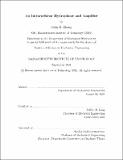An Intracochlear Hydrophone and Amplifier
Author(s)
Zhang, John Z.
DownloadThesis PDF (8.112Mb)
Advisor
Lang, Jeffrey H.
Terms of use
Metadata
Show full item recordAbstract
Assistive hearing systems combining a fully-implantable microphone and electronics with a cochlear implant would enhance directional and focused hearing by taking advantage of ear mechanics. They would be usable in almost all environmental conditions throughout the day and night. Current implantable microphones suffer from unstable mechanics, poor signal-to-noise ratio (SNR), and low bandwidth. Here, we use analytical modeling, a finite-element model, and experiments to design a polyvinylidene fluoride-trifluoroethylene (PVDF-TrFE) intracochlear hydrophone and amplifier system for high-bandwidth sensitivity, surgical viability, and improved SNR by electrical shielding and circuit design. Our analysis shows that the copolymer PVDF-TrFE should be used due to its higher hydrostatic sensitivity, the sensor area should be maximized to maximize gain, and the length should not exceed a maximal value determined by the bandwidth requirement. A short-circuit-topology charge amplifier maximizes the SNR of the sensor by minimizing noise and attenuating electromagnetic interference by shielding. To calibrate and verify our fabricated hydrophones we employ a vibrating water column method to generate a known pressure distribution. We find the measured response of our sensor and amplifier perform are in alignment with our analytical models. In particular, we achieve a sensitivity of 215 aC/Pa, a bandwidth of 470 Hz to 16 kHz, and a SNR of 38.6 dB at 1 kHz for a 40 µm thick sensor of size 15 mm × 0.5 mm. We believe our approach to be a promising candidate to bring fully-implantable assistive hearing systems closer to reality.
Date issued
2021-09Department
Massachusetts Institute of Technology. Department of Mechanical EngineeringPublisher
Massachusetts Institute of Technology